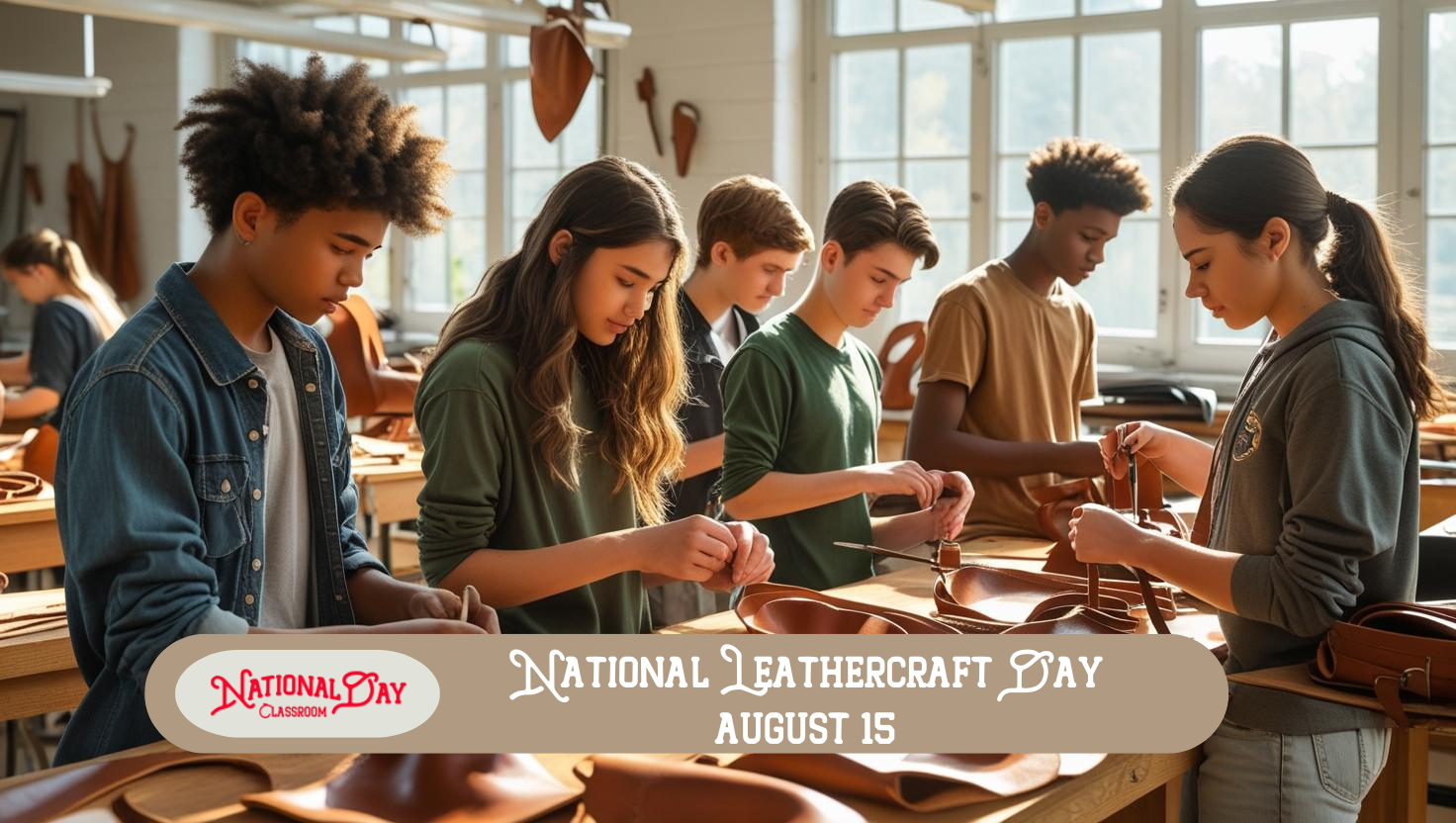
📖 Story: “Cal and the Leathercraft Mystery”
It was a warm August morning when Cal walked into Mr. Delaney’s classroom and noticed something strange:
On each desk sat a small square of brown leather, a hole punch, and a bundle of colorful cords.
“Whoa,” said Cal, plopping into his seat. “Is this some kind of survival class now? Are we making slingshots?”
Mr. Delaney chuckled from the front of the room. “Not quite, Cal. Today is National Leathercraft Day, and we’re going to learn a bit about the history of leatherwork—and even try some ourselves.”
Lena, always the curious one, raised her hand. “Isn’t leather, like, just for boots and biker jackets?”
“Or saddles,” added Jordan, who loved horses.
Mr. Delaney nodded. “All of the above—and a lot more. Leather’s been around for thousands of years. People used it for clothes, tools, armor, even artwork.”
“I thought it was just a fashion thing,” said Sam, examining the leather piece like it might jump. “You know, wallets and purses.”
“That too,” said Mr. Delaney. “But leathercraft is more than just making stuff—it’s about design, tradition, and skill.”
As the class watched a short video about traditional leather tooling, Cal found himself fascinated. He hadn’t realized people still made things by hand like that—pressing designs into leather with metal stamps, cutting patterns just right, threading lace through tiny holes.
When it came time to start their own mini project, Cal hesitated. “What if I mess it up?”
“You won’t,” said Lena, already punching holes in her leather piece. “And even if you do, it’s part of the process.”
“Mine’s gonna be a wrist cuff,” said Jordan, “with my horse’s name on it—Stormy.”
Cal decided to make a keychain with his initials. As he worked, carefully lining up the holes and threading the cord through, he felt something surprising: focus. No buzzing phone, no rush—just the rhythm of hands and material.
By the end of the period, the room was filled with proud smiles and the faint smell of leather. Everyone held up their creations, rough but real.
“You know,” said Cal, turning his keychain over in his hands, “I didn’t think I’d like this. But it’s kinda cool. Like…quiet cool.”
Mr. Delaney smiled. “That’s the craft talking. It has a way of surprising you.”
💬 Discussion Questions:
- Why do you think Cal was surprised by how much he enjoyed leathercraft?
- What are some things you can learn from making things by hand?
- Can you think of a craft or skill you’d like to try?
🪡 Classroom Lesson Plan: National Leathercraft Day
🎯 Grade Level: 5–12
⏰ Duration: 1–2 class periods (45–90 minutes total)
🗓 Date: August 15 – National Leathercraft Day
📚 Subject Areas: Art, History, Social Studies, Career & Technical Education (CTE)
🎯 Objectives:
By the end of the lesson, students will:
- Understand the history and cultural significance of leathercraft.
- Learn basic leatherworking techniques.
- Create a small leathercraft item (or a paper version if leather is unavailable).
- Reflect on the role of craftsmanship in culture and careers.
🧠 Warm-Up Discussion (10–15 min)
Ask:
- What is leather? Where does it come from?
- What do we use leather for?
- Can you think of any jobs or cultures where leathercraft plays a big role?
Show a short video (~5 min) about the art of leathercraft.
Example: Search YouTube for “Introduction to Leathercraft” or “Tandy Leather Basics.”
🕰️ Mini History Lesson (10–15 min)
Give a brief presentation (or reading handout) covering:
- The origins of leather use (prehistoric times – clothing, tools, shelter).
- Leathercraft through the ages: ancient Egypt, Native American traditions, medieval Europe.
- The industrialization of leather production.
- Leather in fashion, sports, and trades today.
Optional Activity: Map It Out — Have students identify regions where leather was historically significant.
🧵 Hands-On Activity (25–45 min)
Option A: Real Leathercraft Project (materials needed)
Students create a simple leather keychain, bracelet, or patch using:
- Pre-cut leather blanks
- Hole punch
- Rivets or snaps
- Stamps, mallets, edge bevelers, waxed thread (optional)
Option B: Simulated Leathercraft with Paper/Felt
If leather materials aren’t available, mimic leathercraft using:
- Brown cardstock or felt (to simulate leather)
- Hole puncher
- Yarn/thread
- Beads, markers, or paint pens for “tooling”
Focus on:
- Planning a design
- Measuring and punching holes
- Simple lacing or stitching
📒 Reflection / Exit Ticket (5–10 min)
Ask students to write a short response:
- What did you enjoy or find challenging about leathercraft?
- How is this type of work different from modern manufacturing?
- Would you consider a career or hobby in craftsmanship?
📦 Materials List
For Real Leathercraft:
- Leather scraps or kits (Tandy Leather, Amazon, etc.)
- Mallets, stamps, rivets
- Hole punch, scissors, lacing
For Simulated Craft:
- Brown cardstock, felt, or foam sheets
- Hole punch
- Yarn, markers, glue, scissors
🧑🏫 Extensions & Enrichment
- Invite a local leatherworker for a demo or career talk.
- Watch a documentary on traditional leathercraft (e.g. saddle-making, shoemaking).
- Research how different cultures use leather symbolically or practically.
- Link with other topics: sustainability (vegetable-tanned leather), animal ethics, fast fashion vs. handmade goods.